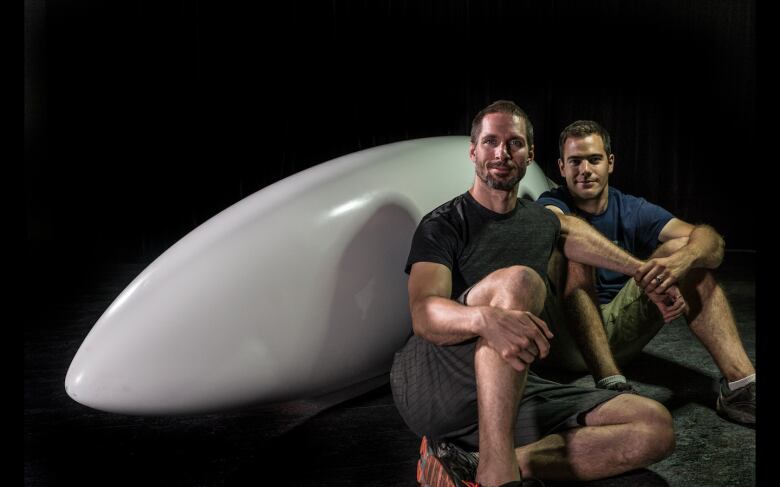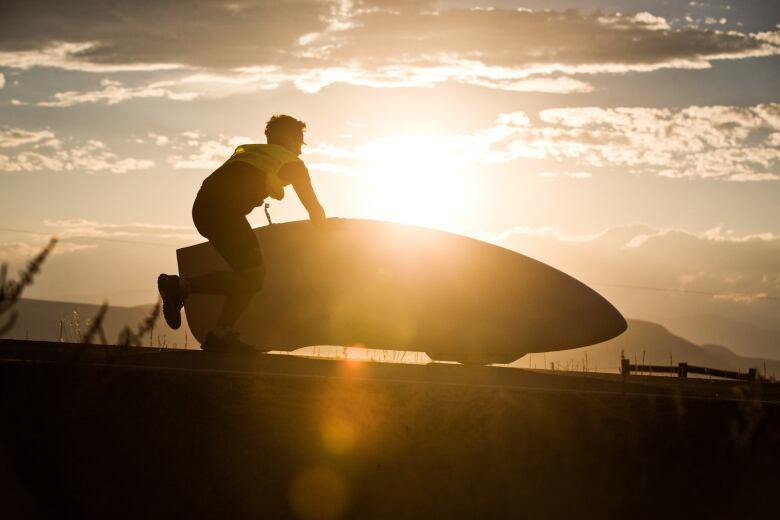Human-powered vehicle speed record broken by Canada's Aerovelo
Toronto team already known for winning human-powered helicopter prize

A Canadian team has broken the record for the fastest human-powered vehicle in the world.
Todd Reichert of the Toronto-based team Aerovelo managed to crank Eta a recumbent bicycle enclosed in an aerodynamic shell to a speed of 139.45 kilometres per hour (86.65 miles per hour), winning the World Human-Powered Speed Challenge in Battle Mountain, Nev., this past weekend.
In fact, Reichert first broke the previous world record of 133.8 kilometres per hour (83.13 miles per hour) last Thursday, then broke his own record twice in subsequent days of the week-long competition.
"This year, we were just blasting down that course," Reichert recalled. "It just happened so quickly. Within a minute, you're over 100 kilometres an hour. At that point, you're just flying."
It takes eight kilometres (five miles) to get up to full speed. The racers are clocked during a 200-metre stretch, then slam on the brakes and slow down for the last kilometre of the race.
Reichert said he realized he had broken the first record while looking at the data display inside his vehicle with 2.5 kilometresleft to go in the course.
"I just knew we had it. And at that point, it was just very exciting to see how much we could smash it by," he told CBC News.
Reichert and his engineering partner, Cameron Robertson, started working on human-powered vehicles while they were graduate students at the University of Toronto before founding Aerovelo.
This isn't their first record they've previous broken records for the longest human-powered helicopter flight, winning the coveted $250,000Sikorskyprize,and the longest human-powered ornithopter flight.
Nor is this their first bike design. But "Eta is the first bike that we've designed purely for speed," Robertson said.
In fact, it was designed specifically to compete at the annual competition run by the International Human-Powered Vehicle Association on the flat,9.7 kilometredesert course at Battle Mountain each fall.
Tiny and windowless
Fundamentally, Eta named for the Greek symbol used in the field of engineering to denote efficiency is similar to that of many of its competitors.
It's made primarily of a carbon fibre composite a material that's strong, light and still capable of holding a complex shape. The frame is very large and stiff for efficiency. Components like chains and tires are chosen to give the highest possible performance. The aerodynamic shell that fits overtop is windowless, to reduce drag the pilot sees what's outside via a screen connected to two tiny cameras outside the vehicle.

The vehicle is as snug and narrow as possible around the pilot in this case, it was custom-built for Reichert, a national-level cyclist (and speed skater). It was a perfect fit right down to the width of his shoulders.
"Your shoulders are literally connected to the bike," Reichert said. That allows him to push harder and helps stabilize the bike.
He said he thinks his double role as pilot and engineer helped the team to succeed.
"When I'm testing the bike and I feel something, I can speak to it in engineering terms and come up with solutions together."
Robertson said the team also worked painstakingly for long hours since September 2013 to design and build a shell with the leastdrag possible under all conditions testing it repeatedly at Toronto's Downsview Airport, and then at longer test tracks in Detroit and Ohio.
That also helped Reichert train and get used to being inside the bike, which he initially found claustrophobic, but now finds comfortable.
Being relaxed is key to keeping the bike stable, but it's not a relaxing environment aside from being very tight, the road vibrations at that speed and echo inside the shell make it extremely loud, Reichert said.
Bumpy start
Despite the team's preparation, the Battle Mountain competition literally got off to a bumpy start. The rough roads en route caused the main shell to rub against the roof of its trailer, digging a divot through the paint. That ruined the aerodynamically smooth surface achieved by hours of polishing and waxing.
The team installed a backup shell they had brought, but in their rush to start the race, the bike tipped over nearthe starting line.

Robertson ran back to town get the first shell and frantically sand it down in time for the next run that afternoon which turned out to be the first record-breaker.
Ultimately, their efforts paid off. While there's still some paperwork to be done to make the record completely official, so far everything looks good.
Reichert said he was constantly aware of all the things that could go wrong, from bad weather, to wind speeds that would invalidate the results, to mishaps like a flat tire.
"Knowing that," he said, "it was just a huge, huge relief to be able to know that we've manage to get it do what we knew it could do."












_(720p).jpg)


 OFFICIAL HD MUSIC VIDEO.jpg)
.jpg)



























































































